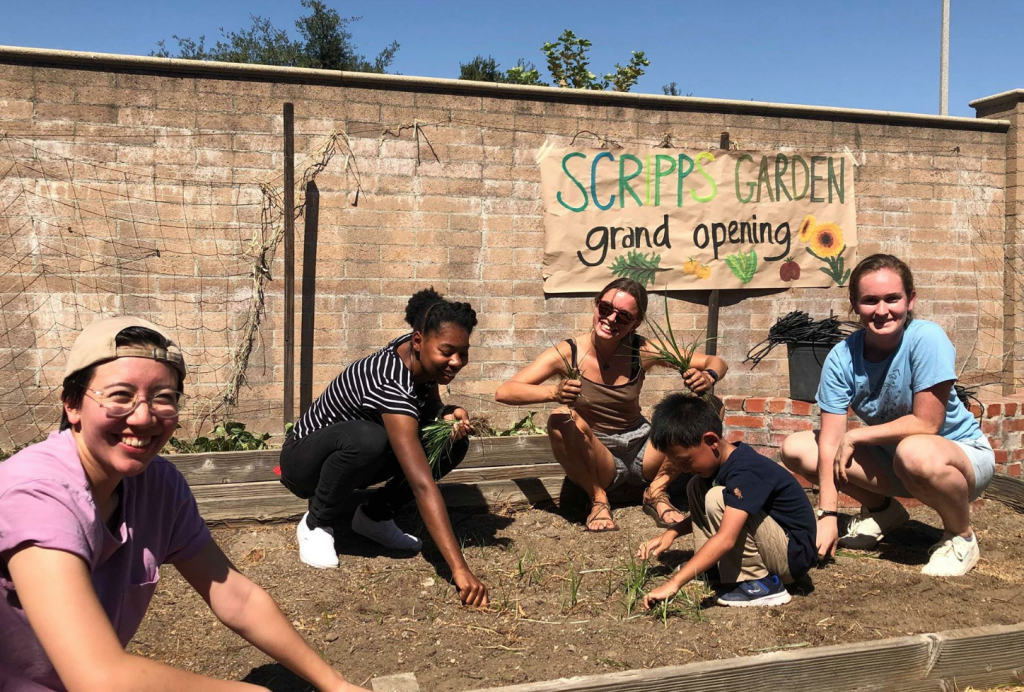By Maggie Thompson ’20
Staff Writer
The garden behind Browning Hall rarely gets foot traffic. In fact, most students have never heard of it at all. To be fair, walls enclosing the space make it hard for determined searchers to find, let alone curious wanderers. One exit door opens to the road between Browning and Frankel/Routt and another leads to the parking lot behind the rose garden; consequently, students can only access the space through Browning by walking north along the main hallway on the ground floor.
Its seclusion has helped keep it out of the public eye, and until recently, out of the lives of the majority of Scripps students.
Yet, the garden has a significant past at Scripps. Fully built and designed by students in 2002, the trees, vines, and physical layout embody collective student organizing. Over the years, the garden has hosted sustainability fairs, facilitated campus composting and grown organic food for the dining hall and the local community. However, due to a lack of consistent institutional leadership tending to the space, the garden has slowly become forgotten in recent years.
Internal knowledge of the garden has generally stayed within the Scripps Garden Club and its members, yet there were no continuation records after the leaders of the 2017-2018 school year graduated, according to current garden leadership. During that same time period, Scripps also hired a new Landscapes Operations Manager with limited institutional memory.
Today, the garden is run by Sophie Perry ’22 and Emma Crownover ’22, two student leaders passionate about environmental justice, social change and food justice. As the new Scripps Student Garden Coordinators, they see the garden as a powerful nexus of those fields.
After the garden’s grand re-opening on Sept. 21, Perry and Crownover are working diligently to revitalize the space and the influence it can have on the Claremont community. Their new roles include “coordinating maintenance, plantings, and harvestings in addition to maintaining a compost program for residence halls kitchens and overseeing the care of the herb garden all while promoting the revived area (including the BBQ) for student use,” Crownover said.
Yes, there is a BBQ grill in the student garden. In addition to the grill, the garden is currently packed with a full bed of lettuce, another full bed of kale, some radishes, rainbow carrots, yellow and red beets, swiss chard, calendula, nasturtiums, and two varieties of arugula. More is still to be planted this season and in the coming spring.
Perry and Crownover are bringing big changes to the garden. This year, the pair has decided to rebrand the Scripps Garden Club as the Scripps Student Garden. Though a seemingly minor change, the distinction draws from a powerful reenvisioning of the garden’s purpose this year and for years to come. Perry and Crownover want the garden to be a vibrant community space for all students regardless of membership or participation in a club. They want all students to get their hands in the dirt without feeling dirty.
According to Perry, “that means spreading awareness about the student garden space and encouraging everyone, regardless of participation in weekly meetings, to use the space, eat the veggies, engage in conversations, and build a community around environmentalism and food justice.”
Along with reviving the physical garden, the Scripps Student Garden is partnering with the SAS Sustainability Chair to develop long-term off-campus gardening opportunities to support food justice in the community surrounding Claremont. They are currently working with Huerta del Valle, a local organic community farm in Ontario, so students can help make organic produce accessible to people living in the Inland Empire. At the moment the Student Garden is coordinating weekly volunteer trips to Huerta on Friday mornings from 8 to 11 a.m. However, the long term goal includes offering compensated internships for students working with Huerta, as well as making farm volunteering a program that provides class credit.
While the Scripps garden has fallen quiet in recent years, the space will soon hold powerful conversations and new kinds of life.
For those interested in getting more involved, join the Scripps Student Garden facebook group or follow the Instagram account @ScrippsStudentGarden.
Image Credit: Sustainability at Scripps
10/10, Volume XXIX, Issue 2



